Abstract
The achievement of United Nations Sustainable Development Goals, related to energy and resource use, is a critical issue for small and insulated communities. In many minor islands, solar energy is not correctly exploited, and electrical heaters are connected to weak grids with very a high share of generation by fossil fuels. As a consequence, there is the necessity to assess the potential and the suitability of diffusion of alternative systems to avoid dependency on the electrical grid and reduce carbon emissions. This paper aims to evaluate the technical and economic performances of some alternative systems exploiting renewable energy for domestic hot water production. Four different systems were simulated and studied: a heat pump connected to the grid, a heat pump coupled with a photovoltaic plant, a heat pump combined with a solar thermal collector, and a solar thermal plant. Moreover, heat and electricity storages were studied for reducing impacts on the distribution network. The work presents data gathered for a study on energy-retrofit strategies on Lampedusa Island (Italy, 35°30′56″ north (N), 568 degree-days). Finally, to select the most cost-effective plant, an economic analysis of the chosen systems was carried out. This analysis shows that the best net present values are associated with the heat pump (HP) coupled with a stand-alone PV system and a small battery and solar thermal-assisted HP. The shortest payback time was calculated for the solar thermal system.
1. Introduction
Most minor islands are not interconnected to the main national electrical grids, and energy is provided by power generation systems consisting of thermal power plants [1]. This causes a financial dependency on the price of fossil fuels [2] and high electricity generation costs [3]. For this reason, island communities are facing numerous energy challenges regarding fuel import dependency and the transport of fuel supply [4]. Furthermore, small islands represent a typical example of such communities, for which the final users’ energy consumption often depends on an electricity source provided by diesel and heavy-fuel oil power plants [5]. Neves et al. [6] proposed a characterization of island energy load based on economic, demographic, and cultural criteria. They underlined how islands with the highest demand per capita are generally located in developed countries, while they have a considerable tourist vocation that strongly influences both the energy consumption and the load profile of the island itself. It would be consequently advantageous to increase the energy efficiency of the whole system via the use of local renewable energy sources (RES) at large scale or by implementing retrofit strategies at the end-user level (including building automation control, small RES plants, etc.) [7,8]. As Papadopoulos [9] affirmed, RES installation is a suitable action to decrease the dependency on fossil fuels and resulting environmental problems, because, in general, they are free from large emissions and locally available. Many studies are available on the use of renewable energy sources on islands. For example, Chen et al. [10] studied a pathway for small islands to replace fossil fuels by renewable sources, applied to a case study in Jamaica. They found that renewable energy can be achieved in such a manner as to satisfy and be in line with the Intergovernmental Panel on Climate Change guidelines for limiting temperature rise to 1.5 °C. The aim of the study of Alves et al. [11] was to analyze the impact of the interconnection of two Azores small islands in the path to 100% RES for the whole energy system. Bertheau [12] focused his attention on Cobrador Island in the Philippines to study the impact of providing more affordable, reliable, and sustainable access to energy on consumption patterns, appliance uptake, and overall socio-economic development. To do this, similarly to this study, a survey was conducted to assess the impact of providing a continuous renewable-based power supply on local development and the sustainable development goals. Meschede et al. [13] proposed a general method to classify global islands with regard to RES installation potentiality, employing cluster analysis based on climatic, physical, and socio-economic parameters. The possibility to convert the existing thermal-power plant into combined heat and power (CHP), i.e., a cogeneration system, including the construction of district heating/cooling networks, was investigated by Beccali et al. [14]. Nevertheless, this study conducted on six Italian small islands demonstrated that CHP technology is only moderately economically attractive when public support mechanisms are included in the analysis. Better results are achieved if hybrid renewable poly-generation systems are considered; however, once again, huge investments are needed. Indeed, the economic attractiveness of such systems is related to the linear density of the energy demand and to the fact that the majority of the energy available for heating and cooling purposes is currently used. Calise et al. [15] studied an innovative poly-generation system powered by solar and geothermal sources on Pantelleria Island. The described plant is able to cover the electricity and the heat demands of a small community, as well as to simultaneously cover the freshwater demand of the island. In another work, Calise et al. [16] investigated the possibility of integrating energy and water supply systems so that excess wind power production could be used in desalination units to supply the freshwater demand on Cape Verde Island. The main idea was to use desalinated water in a pumped hydro system in order to store the extra produced power from wind and to fulfill the gap between intermittent RES production and the island energy demand. Despite the recognized RES potentiality within small islands, the current share of installed RES plants with respect to the total electricity production is generally very low, even if a high potential of exploitation is available within the territory [17,18]. In this regard, Ciriminna et al. [19] identified some critical barriers against a significant penetration of renewable energy on Sicilian islands, which are mainly related to local regulations and landscape management that usually forbid RES large-scale plant installations. It was also observed that an interactive strengths, weaknesses, opportunities, and threats (SWOT) analysis on the energy system could contribute to a collective and social learning process facing institutional, organizational, or common problems that usually inhibit the application of sustainable strategies on small islands [20]. Even though RES large-scale plants could undergo economic and administrative barriers, retrofit actions at the building level could, in turn, be diffusively proposed. Indeed, it was largely proven that they could lead to a substantial reduction in the energy demand toward a Net Zero Energy Building target [21]. Moreover, the extensive use of renewable energy sources could strongly influence the load curve of the community, as demonstrated by Ilkan et al. [22] for the island of Northern Cyprus where the use of solar thermal water heater was intensely encouraged by the local government, leading to a maximum yearly saving about 72 GWh [23]. Indeed, solar thermal technologies can be a very good solution to decrease the electricity demand by domestic hot water [24], because a great amount of energy consumption also takes place during the operational period, in order to satisfy the demand of domestic hot water (DHW) [25]. Moreover, the use of active and smart systems at the building level, enabling the possibility of implementing demand-side management (DSM) policies, could be easily applied in a typical building on Lampedusa Island (Italy), controlling the effect of flexible electrical loads on the load curve of the island. Among flexible loads, the one most influencing the peak and the energy consumption of a typical house in Lampedusa is the electrical storage water heater (ESWH). For example, Aguilar et al. [26] studied how photovoltaic systems interact with the heat pump water heater (HPWH) for domestic hot water (DHW) production without relying on batteries but only on a thermal storage tank. It is then reasonable to suppose that better results could be achieved if both strategies (use of RES source with high efficiency of water heater and demand response strategies) were applied.
The present work relies on energy-retrofit strategies on Lampedusa Island (Italy, 35°30′56″ north (N) 12°34′23″ east (E), 568 degree-days). Lampedusa is one of the Italian small islands not connected to the mainland electric grid, for which the Italian Government established financial support to avoid a local inhabitant fee for extra costs in electricity production, according to a social equity principle. Since 2014, the government proposed to gradually abolish the support mechanism while promoting the use of RES. Specifically, in 2017, it introduced a legislative decree aimed at financing different energy-retrofit strategies, including the installation of solar thermal plants or heat pumps for domestic hot water (DHW) production. The general goal for Lampedusa Island by 2030 is to reduce the yearly electricity consumption by up to 37,660.0 MWh via installing photovoltaic plants with an overall 2140.0-kW peak power and via installing 2370 m2 of solar thermal collectors. It is necessary to carefully investigate the best integration patterns for having an optimal system implementation together with suitable operation strategies [27] and to compare alternative systems for the optimization of plants [28] both in economic and in environmental terms [29]. Razavi [30] compared combinations of a solar-assisted ground-source heat pump to meet heating and DHW loads in Zahedan city, Iran. They studied the potential exploitation of a geothermal source and of solar energy. Furthermore, Guarracino et al. [31] developed a dynamic model of a hybrid photovoltaic/thermal (PVT) collector with a sheet-and-tube thermal absorber. The aim was to evaluate the annual generation of electrical energy, along with the provision of DHW, from the thermal energy output. They highlighted the importance of using real input data at high resolution for a correct estimation of the yearly and monthly performance of the system, as opposed to averaged data. This could be very important, especially if a novel control strategy that can adjust the system’s outputs in response to varying demands has to be designed. According to this legislative panorama and to the state of art, the present work analyzes the impact of the substitution of existing electric storage water heaters (ESWH) with dedicated HPWH, eventually coupled to a photovoltaic (PV) plant, a solar thermal plant (ST), or a solely ST system. The goal is to evaluate how thermal and electrical storage could interact with each other while exploiting renewable energy sources and guaranteeing DHW supply at a proper water temperature and to evaluate the technical and economic performances of these alternative systems exploiting renewable energy for domestic hot water production. The paper is organized as follows: Section 2 shows the method applied to conduct the work, describes the simulated systems and the models, and defines the domestic hot water tapping profiles; Section 3 presents the results and, in particular, the performances of the heat pump. the conventional electric heater, and the photovoltaic-assisted systems, along with a description of the solar thermal-assisted water heaters and an economic analysis; finally, the last section reports the conclusions.
2. Methods
The present work is based on model simulations by the TRSNSYS 17 platform. It is based on an hourly weather database from Meteonorm software and on the DHW demand input inferred by a monitoring campaign on some residential consumer units (users) in Lampedusa. Two users in Lampedusa were chosen as representative with respect to statistical data. They are both families made up by two components living in a typical residential home on the island (120 m2). The experimental campaign, as well as data processing, was carried out by researchers from the University of Palermo and National Agency for New Technologies, Energy and Sustainable Economic Development (ENEA) involved in the project. Data were acquired with a 10-min time-step. In order to obtain reliable data via simulation, a 10-min time-step was chosen, and results were then processed on hourly, daily, and monthly bases.
2.1. Workflow
In this study, the operation and the efficiency of a set of systems for DHW production were determined through dynamic simulation models using the TRNSYS 17 platform [32]. In order to appreciate the interactions with electrical grids and to test time-shifting actions that can be implemented, an analysis on a short time scale (minutes) was conducted.
A preliminary task was to correctly identify the typical DHW consumption hourly profile (tapping) and the volume of the daily-consumed DHW via a representative final user on Lampedusa Island. These values (hourly tapping profile and DHW demand per day) depend on the number of persons in the consumer unit and on their habits. Moreover, the use of hot water is influenced by seasonal fluctuations due to climatic conditions. The method is based on data extracted from the observations of a representative consumer unit during an experimental campaign. In addition, statistical data on population and housing in Lampedusa and the results of previous studies [33,34] were considered.
According to the last population census, most families in Lampedusa are formed of two or three people (about 42%). Through a survey, presented in previous studies [5], it was verified that the most widespread DHW production plant is an 80-L ESWH equipped with a 1200-W electric resistance. Moreover, due to the touristic vocation of the island, the number of people living in apartment units varies from two in the winter to three in the summer.
In order to identify the average daily DHW consumption, the monitored data of energy consumption in the most critical seasons (EDHW) were compared with those calculated using a Trnsys model of the heater. Indeed, simulations were conducted by varying the hot water volume demand per day until energy consumption matched the averaged recorded data in the critical months. Maximum (VDHW,max) and minimum DHW demand values (VDHW,min) were respectively calculated in the winter and summer as follows:
where i is the generic number of the month in the year, nmax and nmin are respectively the months in which VDHW,max and VDHW,min values were recorded from the experimental campaign, and fm,i is a monthly correction factor. A linear trend was then used to extrapolate the daily DHW volume for the other months.
In order to generalize results, hot water consumption per person per day was calculated. Similarly, the hourly frequency of on/off ESWH cycles was calculated from monitored data to build the hourly tapping profile as follows:
where xh is an hourly factor for the VDHW,i, fh is the operation time of the ESWH, and fMAX is the maximum frequency value in the day. Yearly energy consumption and temperature trends in the water storage were used to run the simulation models of possible retrofit options.
Based on the actual DHW demand, remarks on plant sizing and service modes were made using simulations in real operating conditions. In order to evaluate the role of the thermal storage for the best exploitation of solar energy while ensuring comfort conditions, we introduced three indices.
They were utilized for a first sizing of the proposed plants and can be calculated as follows:
where TDHW is the outlet tank temperature, n.hourT_DHW40 is the number of hours when the outlet tank temperature is 40 °C, n.hourtot_1. is the number of hours for which mDHW > 0, and Tset is the setpoint temperature. Additionally, the discomfort index (DI) and the potential discomfort index (PDI) [35] were introduced in order to check how many hours in a given period (month, year) the outlet tank temperature (TDHW) dropped to a minimum comfort temperature (TDHW.-comfort = 40 °C) during tapping events (number of hours, n.hourtot_1, for which mDHW > 0) and no-tapping events (number of hours, n.hourtot_2, for which mDHW = 0). The setpoint index (SPI) allows quantifying how many times in a detected period (n.hour) the tank temperature goes below a desired setpoint value (Tset).
Furthermore, three additional indices [36,37] were calculated to measure the electric storage and evaluate its behavior. In particular, the average fractional state of charge (FSOCav) is equal to the ratio between the mean values of charge in a defined period (Ebattery.av) and its nominal capacity (Ebattery.max). The electric storage index (ESI) quantifies how many times in a detected period that the charge in the battery (SOC) drops to a minimum value (SOCmin) or overcomes a maximum threshold. The first was set equal to the HPWH daily consumption (BImin), while the second was assumed to be equal to its nominal capacity. They can be calculated using the following formulas:
where Ebattery.av is the mean value of charge in a defined period, Ebattery.max is the nominal capacity, SOC is the state of charge in the battery, SOCmin is the minimum allowed value of the state of charge in the battery, SOCMAX is the maximum value of the state of charge in the battery, and SOCh is the calculated state of charge in the battery in a specified time-step.
Finally, two financial indices were further introduced and calculated for the studied systems. They are the net present value (NPV) and the simple payback time (SPT)
where Co is the initial cost, including purchase and installation costs, Teq is the equivalent time, Rz is the economic saving with respect to the current DHW production system, and Mz is the maintenance cost of the retrofit plant.
The above-described methodology is represented in Figure 1.
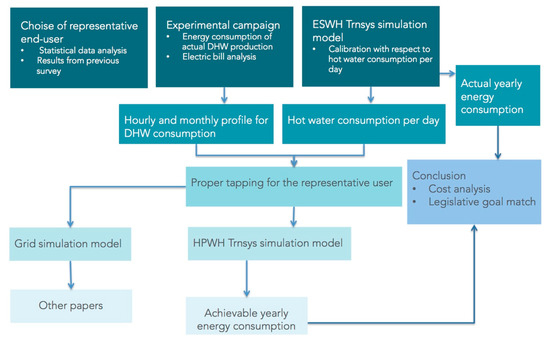
Figure 1.
Workflow of the presented work.
2.2. Simulated Systems
Four different combinations of plants for DHW production were considered as alternatives to the standard ESWH (Figure 2). The following categories of technologies, currently available on the marketplace, were selected:
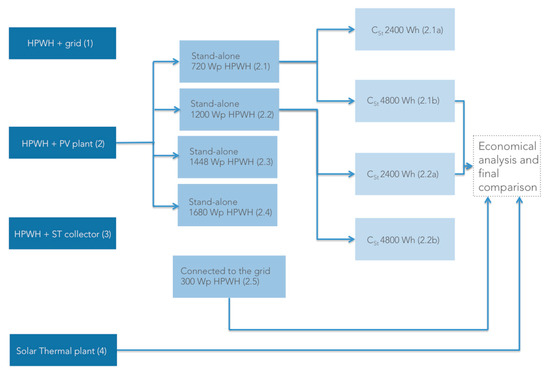
Figure 2.
Scheme of the simulated plants.
- System 1, heat pump water heater connected to the grid;
- System 2, heat pump water heater coupled with PV plant;
- System 3, heat pump water heater coupled with ST collector;
- System 4, solar thermal plant.
Moreover, in order to further investigate the performance of PV-assisted HPWHs, two different sizes of System 2, operating in stand-alone mode, were simulated. In particular, the so-called system 2.1 was characterized by a peak power of 720 Wp, while system 2.2 was characterized by a power of 1200 Wp. Solutions 2.1a and 2.2a, as well as 2.1b and 2.2b, share the same battery set-up, i.e., 2400 and 4800 Wh, respectively.
The stand-alone plants were analyzed in order to verify how the electrical storage size influences the overall system performance while ensuring comfort conditions and the energy-saving goal. The electrical storage was sized based on the worst working conditions for the overall plant, i.e., the day with the highest daily consumption and lowest solar irradiation. In addition, an electrical consumption of 1200 Wh for the HPWH was assumed. Electrical storage was supposed to be able to ensure two and four days of autonomy (Naut). The two selected solutions (2400 and 4800 Wh) were applied to both stand-alone configurations. They were named system 2.1a, system 2.1b, system 2.2a, and system 2.2b. Additionally, a grid-connected plant (system 2.5) was investigated. System 2.5 was sized in order to meet the yearly consumption of the HPWH without accounting for contemporaneity issues between load and production. In that way, the overall yearly energy balance between produced and consumed energy was set to zero. Furthermore, the HPWH could be considered to virtually consume only the renewable energy generated by the PV, using the electrical grid as virtual electric storage.
2.3. Simulation Models
The HPWH considered for systems 1, 2, and 3 was an all-in-one air-to-water device. This kind of system uses its DHW tank as a hot sink and includes two wrap-around heat-exchangers. The first one is used as a condenser in the heat pump cycle, while the other is suitable for connecting additional heat sources. The main features of the HPWH are listed in Table 1. These data refer to the standard UNI EN 16147:2011 [38] that introduced two testing cycles. Both tests rely on a heating cycle aimed at warming water from 10 °C to 55 °C. In the first test, inlet air temperature and humidity were fixed at 7 °C and 89%, respectively (cycle A7/W10-55), while the second test relied on inlet air temperature at 15 °C and relative humidity at 74% (cycle A15/W10-55). The HPWH model was run in stationary conditions with an input according to EN 16147:2011.

Table 1.
Heat pump water heater (HPWH) features from technical datasheet. DHW—domestic hot water.
Since no Trnsys type is available for simulating the described HPWH, a specific model was set up for the heat pump operation (Figure 3). It was based on the combined use of two available types. In particular, type 938 [39] was used for performing the air-to-water heat pump cycle obtaining the heat delivered to the water sink (Q-to-water) at a given time step (15 min). Q-to-water was used as input in type 1237 [40] to evaluate the water tank temperature at the specific tapping condition. The water temperature was used as input in type 938 with the tank as the heat sink of the HP. The refrigerant flow rate was evaluated as a function of Q-to-water, forcing a temperature difference between the inlet/outlet of the fluid equal to 5 °C in each time-step. The proposed model was run at the nominal condition described in EN-16147:2011 (A15/W10-55 and A7/W10-55 cycles). It was validated through the comparison of figures of energy consumption, coefficient of performance (COP), and warm-up time reported in the technical data sheet, obtaining relative errors below 10%. Figure 3 shows the simulation model scheme.
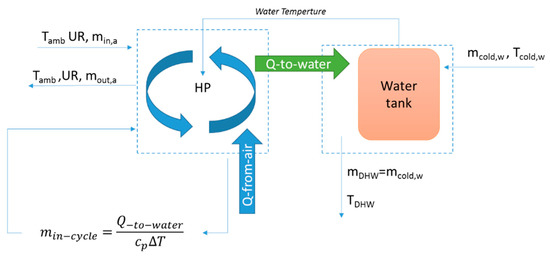
Figure 3.
HPWH simulation model.
As previously mentioned, System 2 was modeled to test how thermal and electrical storage could interact each other for achieving the maximum energy (electricity) saving target by ensuring comfort conditions and by exploiting the solar radiation source as much as possible. For this reason, three different PV plants were supposed based on the results of HPWH simulation: two stand-alone (SA) systems, characterized by two different rated peak powers, and a grid-connected system. The PV panel component system characteristics are presented in more detail in the next paragraph, while component features are listed in Table 2 and Table 3.

Table 2.
Photovoltaic (PV) panel features by technical datasheet. GC—grid-connected; SA—stand-alone.

Table 3.
PV panel and solar thermal plant (ST) collector features by technical datasheet.
For the systems based on combination with solar thermal collectors (3 and 4), different configurations were supposed. First of all, the main solar thermal component consisted of a flat-plate collector with highly selective surface properties (efficiency parameters are listed in Table 3). Furthermore, we considered a forced circulation water loop scheme, driven by a 50-W pump. System 4 is a solar thermal plant with a conventional electric heater as back-up. System 3 includes a solar thermal system coupled with an HPWH. In the latter case, the ST system was connected with a second wrap-around heat exchanger present in the HPWH tank.
In order to compare the analyzed systems, the same tapping profile and thermal storage characteristics (200-L DHW tanks equipped with a 2000-W back-up electric heater) were adopted for all case studies. The DHW tank was simulated using the Trnsys type 1237 [32]. Such storage is suitable to be connected with different energy sources and includes a wrap-around HX calculation algorithm, appropriate for different alternative generation sources (Figure 3). Furthermore, the same components and types were used for all the simulated models. Daily and monthly schedules were applied for determining the hourly tapping input as inferred from the monitored data. As mentioned before, in order to assess the seasonal fluctuation of DHW thermal energy demand due to climate conditions, the calculated water temperature in the tank was set as input for the thermostat cut-off. Inlet water temperature from the public water network was set equal to ground temperature at 2 m depth by means of type 77 [32]. In systems 1, 2, and 3, boiler setpoint temperature was based only on HPWH constraints (Table 1) and was fixed at 63 ± 2 °C.
On the other hand, in system 4, whenever a useful solar contribution was available from the collector loop, temperature in the boiler was allowed to rise to the maximum value (see Table 1) (88 ± 2 °C); otherwise, it was set according to the HPWH limits. The aim was to exploit the water tank as much as possible for the storage of the available solar thermal source.
The overall logical scheme of simulations is depicted in Figure 4.
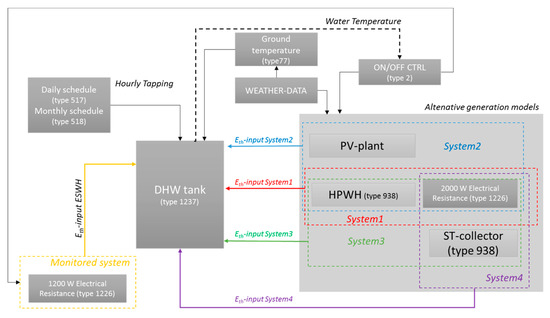
Figure 4.
Trnsys model scheme.
Analyses were performed on yearly and monthly bases and for a typical day per each month, which was selected according to the median daily irradiation values on a horizontal surface (Figure 5). In fact, all the solar collectors were considered with a horizontal tilt angle to fulfill building integration and landscape protection constraints.
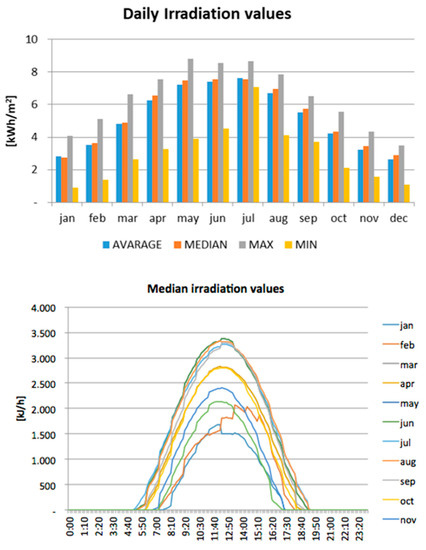
Figure 5.
Analysis of specific horizontal irradiation values on Lampedusa Island, Italy (35°30′56″ north (N)).
2.4. Empirical Definition of Domestic Hot Water Tapping Profiles
Figure 6 shows the average daily energy consumption per month calculated from monitored data for two users equipped with a conventional ESWH system. It is worth noting that, even if different magnitudes of values were observed, monthly data regarding the two detected users had similar decreasing trends from February until July/August. Furthermore, data for the month of September ere probably affected by the presence of a larger number of persons in the residential units.
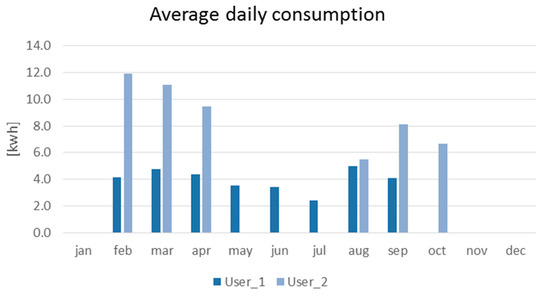
Figure 6.
Monitored data.
Data were processed for determining the frequency of operation of the ESWH system during a typical tapping. Moreover, to obtain the most consistent tapping profile, hourly frequencies when the power values were below the daily median were excluded. Figure 7 shows results in terms of percentage by hour the ESWH was “switched on” with respect to monitored data and to the introduced constraints (Figure 7).
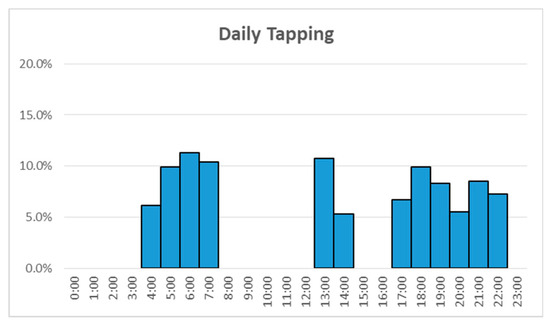
Figure 7.
Tapping profile.
A Trnsys calibration routine was carried out to fit the experimental data with calculations. The model was run, introducing the tapping profile as hourly input. Daily water consumption at 40 °C (input) was varied until the simulated monthly energy consumption (output) matched the recorded figures with a relative error below 5%. The hot water consumption for the monitored consumer units varied from 90 L per day in February to 45 L per day in July (user 1) and from 180 L per day in February to 120 L per day in September (user 2). Average values between users were successively applied for determining a common linear monthly trend. This was calculated according to Equation (2) in order to obtain the monthly correction factor (fm,i) (Figure 8).
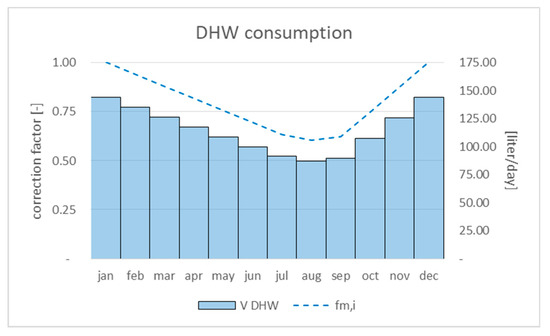
Figure 8.
DHW consumption per day at 40 °C for analyzed consumer residential unit.
3. Results
3.1. Analysis of Heat Pump Water Heater Performance
Comparing the simulation results and reference values of the technical data sheet, relative errors below 5% were obtained. COP was calculated according to international standard procedures. As suggested by EN 16147:2017 [38], an error below 10% for the energy consumption in both warming-up cycles was obtained. These results demonstrated a good accuracy of the model.
As described in Section 2, before analyzing the proposed systems, an ordinary ESWH was also simulated in order to obtain electricity consumption reference values of 1137 kWh per year with monthly values varying from 125 kWh in January to 67 kWh in August for the tapping profile adopted. The simulated results for system 1 were compared with those of the ESWH (Figure 9).
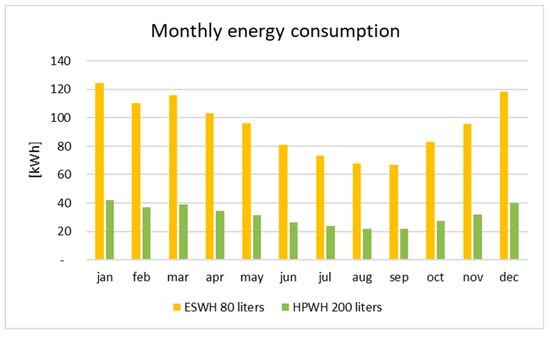
Figure 9.
Comparison between electrical storage water heater (ESWH) and HPWH energy consumption.
It is worth noting that, through the replacement of the conventional system with a heat pump, an average electrical energy saving equal to 65% could be achieved. This is consistent with the rated COP and the higher available storage capacity due to the higher DHW tank volume of the heat pump system. In particular, yearly energy consumption was reduced from 1137 to 375 kWh, avoiding 761 kWh electricity withdrawals from the local grid. It is worth noting that, according to the technical datasheet, the considered HPWH was able to match the thermal demand of the so-called “L” tapping profile [41]. Therefore, it could deliver up to 11.66 kWh of thermal energy per day [42]. Results from simulations presented in a previous work [5,33,34] show that, in the worst case (January), the average thermal demand can be about 4.1 kWh of thermal energy per day.
3.2. Analysis of Stand-Alone Photovoltaic Systems
According to the present work purposes, four stand-alone configurations (HPWH (2.1), (2.2), (2.3), and (2.4)) were considered to outline electrical storage behavior. Preliminary simulations were useful for determining PV plant features to be tested. Looking at the results of simulations, January and December appear as the most critical months with average daily electrical consumption equal to 1.4 kWh per day (Figure 10).
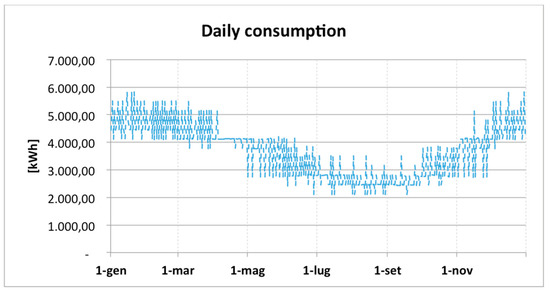
Figure 10.
Daily energy consumption for the system.
Moreover, the HPWH was switched on mainly in conjunction with tapping events in the early morning and in the evening. As mentioned above, the median value of irradiation was calculated. Based on these data, a day for each month characterized by irradiation figures closest to the median was selected. For these 12 days (one per month), the daily frequency of on and off operation of the heat pump in the selected time range was evaluated. Figure 11 shows the percentage of time that the HPWH was “on” in an hour during the year with respect to the adopted tapping profile.
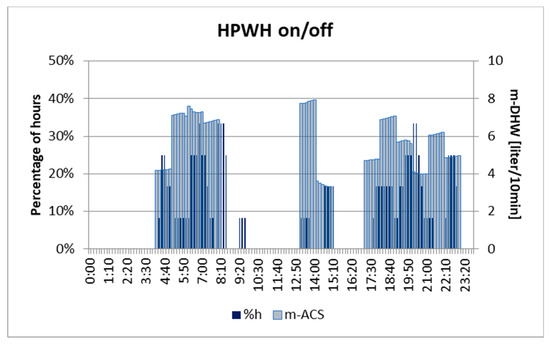
Figure 11.
Percentage of time that the HPWH was “on” in an hour during the year with respect to the adopted tapping profile.
To check the thermal storage behavior in operating conditions, further simulations were run. In this case, the energy produced by the PV plant was exclusively considered to drive the HP, without any electrical storage support. Whenever the temperature tank dropped to the setpoint value and, simultaneously, whenever the power from the PV string was suitable to drive the cycle without relating to the electrical grid or battery, the model allowed the switching on of the HPWH. As described above, four different PV plant sizes were considered: 720 Wp, 1200 Wp, 1440 Wp, and 1680 Wp. They correspond to three, five, six, and seven PV panels, respectively. Table 4 shows the plant configuration with respect to the following features: number of days of autonomy (Naut) for stand-alone (SA) plants, inverter (PInv) and plant power (PPV), battery capacity (CSt), and number of PV panels, for which characteristics could be inferred from Table 2 and Table 3. It can be noted that systems 2.3 and 2.4 were definitively oversized in order to use them as comparison terms with respect to system 2.1 and system 2.2 considering that no battery storage is available.

Table 4.
PV plant features.
In Table 4, the characteristics of the four selected PV plants (systems 2.1, 2.2, 2.3. and 2.4) are listed. The last two plants were definitely oversized in order to use them as comparison terms.
It is possible to see in Figure 12 that all plant configurations could match the summer DHW demand (from May until October) without discomfort events (monthly DI and PDI equal to 0%); moreover, as seen by looking at the irradiance value (Figure 5 in Section 2) and the adopted tapping profile (Figure 7 and Figure 9 in Section 2), winter months appeared the most critical. The next step was to calculate the discomfort indices DI and PDI (Figure 12).

Figure 12.
Temperature trend with reference to comfort limit.
As in this case, the most critical results were recorded in December for the 720-Wp plant (system 2.1) because of the small size of PV generator compared to the HP nominal power and to the low values of irradiation. A higher PV plant power obviously leads to better results (Figure 13).
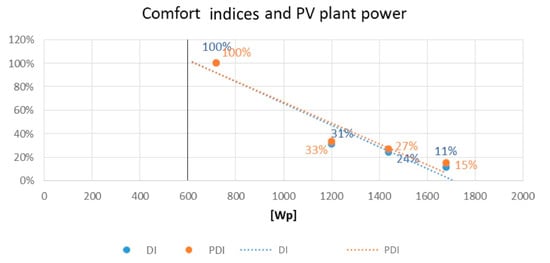
Figure 13.
Yearly comfort indices for the tested PV plants.
Nevertheless, an auxiliary electrical load would be necessary to avoid oversizing of the PV respect to the HPWH nominal power. In any case, using the plant characterized by a power of 1200 Wp (system 2.2), the contemporaneity between the energy needed for DHW production and PV useful production reached values higher than 90% (Figure 14).
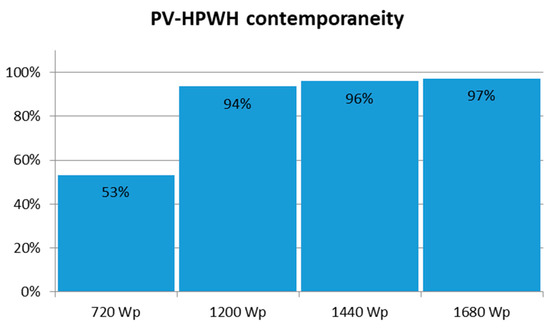
Figure 14.
Contemporaneity between DHW production load and PV useful production.
Figure 15 shows the results obtained for discomfort and storage indices in the most critical month (December) for the SA systems.

Figure 15.
Temperature and battery indices.
It is worth noting that, except for the HPWH + ST (2.1a) systems, all other SA systems with PV plants allowed satisfying comfort conditions, with PDI and DI indices equal to 0%. This means that tank temperature never dropped below the 40 °C comfort limits. On the other hand, only the 1200-Wp plants were almost suitable to preserve the temperature as close as possible to the setpoint one. Finally, focusing on the storage indices, some differences among analyzed systems could be underlined (Figure 16).
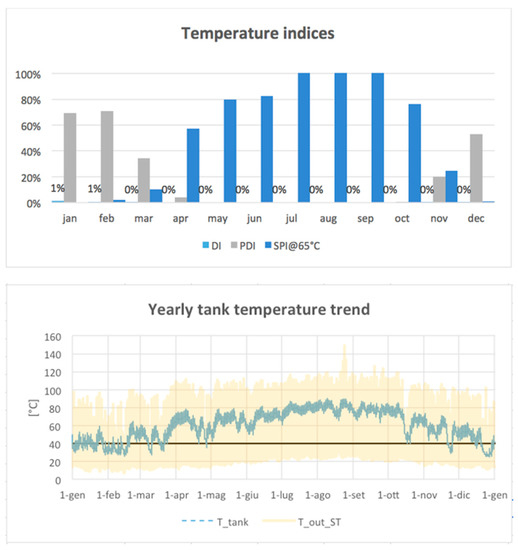
Figure 16.
Temperature indices and storage temperatures for solar thermal systems without electric back up.
Remembering that the BImin index was introduced to evaluate critical situations in which the state of charge drops to the minimum value (HPWH daily consumption), it can be noted that it varied from 68% for the HPWH + ST (2.2a) plant to 0% for the HPWH + ST (2.1b) one. Intermediate values, almost acceptable, were calculated for the HPWH + ST (2.1b) and HPWH + ST (2.2a) systems, with 26% and 44%, respectively. On the other hand, the BIMAX and FSOCav indicate how electric storage was exploited in the critical month. In this way, some oversizing conditions were highlighted for the HPWH + ST (2.2b) configuration (73%). Actually, a higher BIMAX denotes a higher time when the state of charge is close to the battery nominal capacity, indicating that it was not properly used in the system. Summarizing from the present analysis, the HPWH + ST (2.2a) system had the worst performance because it weakly matched comfort requirements. On the other hand, the HPWH + ST (2.1b) system resulted to be oversized with respect to DHW load demand fulfilled by the HPWH. Finally, the GC (2.5) system accounted for a 300-Wp panel. The simulation results show that system 2.5 can annul the yearly consumption of non-renewable primary energy since the PV plant entirely produces the electricity required by the HPWH. Nonetheless, despite the peak power of the system being less than the power required by HPWH, all the produced energy is sold back to the utility. Economic consequences are investigated in Section 3.4.
3.3. Analysis of Solar Thermal System Assisted Water Heaters
Similarly to the PV plant investigation, a preliminary check concerning the temperature indices related to the solar thermal systems was carried out without considering any back-up.
It is worth noting that, also in this case, during tapping events, the comfort conditions were generally ensured all year long (Figure 15), while potential discomfort conditions were recorded only in winter months. On the other hand, considering a setpoint temperature of 65 °C, it has to be noted that the SPI index had average yearly values of 53% while it reached 0% in winter months. This means that the solar thermal system was not able to continuously ensure the setpoint temperature in the tank (Figure 15). Two alternative back-up electrical-based systems were consequently introduced. Firstly, a typical 2-kW electrical resistance was provided in the tank (ST (4) system). Moreover, the previously studied heat pump water heater was coupled with a solar thermal loop (HPWH + ST (3)). Figure 17 shows the comparison between the electrical consumption results of the simple HPWH and the results for the ST (4) and HPWH + ST (3) systems. Taking as a reference the HPWH results, the ST (4) system led to an extra 4% energy consumption from the grid, while the HPWH + ST (3) system allowed 58% electrical saving. Regardless of the choice of electrical back-up, the adoption of solar thermal collectors led to achieving tank temperatures generally included between 65 and 80 °C (SPI index in Figure 17 with yearly average figures of 70% and 11%).
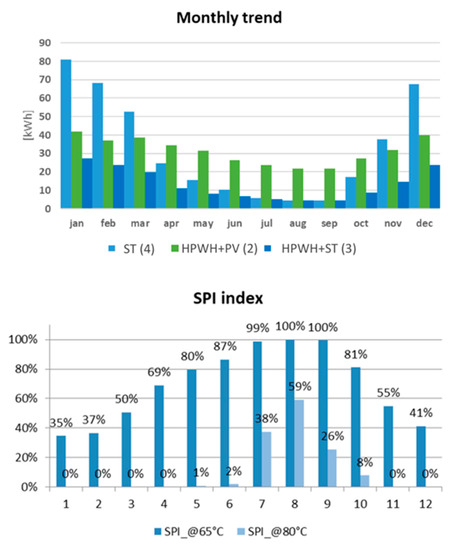
Figure 17.
Top: electrical consumption of the systems; bottom: monthly setpoint index (SPI).
3.4. Economic Analysis and Comparison between Systems
The previous results demonstrated in which ways the selected plants could ensure comfort conditions while exploiting the thermal and/or electrical storage capacity of the systems. For the sake of clarity, the following systems were analyzed:
- System (1), HPWH + grid: heat pump water heater without any RES plant assistance;
- System (2.1a), HPWH + PV, heat pump water heater with a PV plant having 2400 Wh storage capacity and 720 Wp
- System (2.2b), HPWH + PV, heat pump water heater with a PV plant having 2400 Wh storage capacity and 1200 Wp
- System (2.5), HPWH + GC PV, heat pump water heater with a 300-Wp PV plant directly connected to the grid;
- System (3), HPWH + ST: heat pump water heater coupled with a solar thermal plant
- System (4), ST plant: commercial solar thermal plant relying on a solar thermal collector with an electrical resistance back-up and DHW tank
Systems HPWH (2.1b) and HPWH (2.2a) were “discarded” because the sizing was not proper. From the energy saving point of view, taking as a reference an ordinary ESWH system (with 1137 kWh electrical consumption per year), all plants achieved energy savings in a range from 100% for the PV plants to 86% for the HPWH + ST (3) system, with an average of 66.5% for the HPWH and ST (4) system (Figure 18).
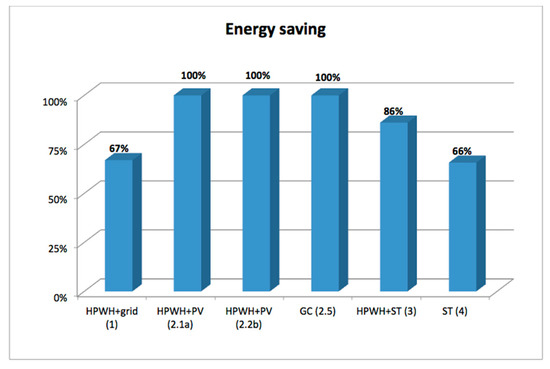
Figure 18.
Comparison of the DHW energy saving.
Differences could be noted when looking at economic indices. In Figure 19 and in Table 5, the calculated net present value and the payback time (PBT) for the proposed systems are reported. System initial costs were estimated via an analysis of the Italian market [43,44]. The average electricity cost from a user’s bill was considered in the calculation (0.23 €/kWh), while the selling price for the produced electricity for the grid-connected PV plant was considered equal to 0.10 €/kWh.
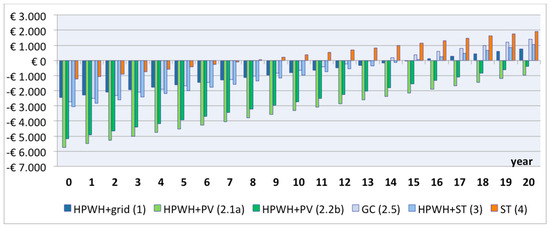
Figure 19.
Cash flow and net present value of selected solutions (without national incentive).

Table 5.
Payback time and net present value (without national incentive).
A 20-year useful lifetime was assumed for all the plants.
First of all, it can be noted that, if no public subsidy is considered, stand-alone PV plants show a negative cash-flow rate, with a consequently negative NPV (Figure 19). At the same time, these systems present the worst payback time, higher than 21 years. On the other hand, all other systems present positive NPV varying from 760 € for the HPWH system to 1902 € for the solar thermal plant with electric back-up. ST (4) and HPWH + grid (1) systems, despite similar energy saving values, strongly differ in NPV and in PBT, with the latter having the lowest value, i.e., half of the first. Finally, low differences could be noted in all figures between the GC (2.5) and ST (4) plants.
The Italian incentive mechanism for such a system allows for some reduction in the purchase price for plant components to be distributed in 10 yearly payments. Incentive values vary from 50% to 65% for PV components and for ST and HPWH components, respectively. Under such circumstances, all systems have a positive net present value estimated at 20 years (Figure 20).
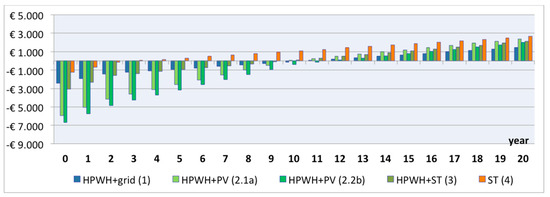
Figure 20.
Cash flow and net present value of selected solutions (with national incentive).
The best NPV is associated with the HP coupled with a stand-alone PV system and a small battery (system HPWH (2.1b)) and the solar thermal-assisted HP (system HPWH + ST (3)). The shortest payback time was calculated for the solar thermal system (Table 6).

Table 6.
Payback time and net present value (national incentive).
4. Conclusions
In this paper, the use of heat and electricity storage, as well as solar thermal and photovoltaic panels to be coupled to a heat pump, was investigated. To do this, four technologies from the marketplace were chosen, simulated, and analyzed: a heat pump water heater connected to the grid, a heat pump water heater coupled with a photovoltaic plant, a heat pump water heater coupled with a solar thermal collector, and a typical solar thermal plant. First of all, the electricity consumption of an ordinary ESWH for a family on Lampedusa Island was calculated through simulation (yearly 1137 kWh, varying from 125 kWh in January to 67 kWh in August). This value was used as a reference to calculate the energy savings achievable with the other systems. It was found that the replacement of the reference system with an electric heat pump could provide an average energy saving equal to 65%. Indeed, in this case, the yearly energy consumption can be reduced from 1137 to 375 kWh, avoiding 761 kWh of electricity withdrawal from the local grid. Regarding the heat pump water heater coupled with a PV plant, four further stand-alone and one grid-connected photovoltaic plants were considered. Moreover, two solar thermal-based systems introduced: one coupled with an electrical back-up resistance (called ST (4)) and the other with the heat pump itself (called HPWH + ST (3)). Firstly, all proposed solar assisted plants were run without accounting for electrical storage (photovoltaic plants) or a back-up system (solar thermal plant) in order to check for their performance by means of a set of comfort indices. Based on the comfort conditions, the most suitable size for a stand-alone PV-plant was detected. Some comfort issues were detected for the systems with 720 Wp. while a peak power of 1200 Wp could dramatically mitigate such a problem. Then, two alternative electric storages were evaluated through a calculation of values for the “battery indices”. The following PV-based plants were then selected: a system characterized by a power of 1200 Wp and a storage capacity of 2400 Wh (called HPWH (2.1a)) and system characterized by a power of 720 Wp and a storage capacity of 4800 Wh (called HPWH (2.2b)). Similarly, the ST plant was firstly evaluated by means of comfort indices. The results showed that, if back-up systems are not included in the systems, setpoint temperature could only not be maintained in the tank during winter months and some potential discomfort events could be detected. By using the system characterized by 1200 Wp, the contemporaneity between the energy needed for domestic hot water production and PV useful yield achieved values higher than 90%. Looking at the comparison between the electrical consumption of the electricity-driven pump water heater and those driven by the solar thermal (called ST (4)) and the pump water heater coupled with solar thermal systems (called HPWH + ST (3)), the solar thermal (called ST (4)) one achieved an extra 4% of energy taken from the grid. By comparing the pump water heater consumption with that of the pump water heater coupled with solar thermal systems (called HPWH + ST (3)), a 58% reduction was evaluated.
In general, from an energy-saving point of view, all plants achieved energy savings concerning the traditional electric storage water heater in use, varying from 100% for the selected photovoltaic plants to 86% for the pump water heater coupled with solar thermal systems (called HPWH + ST (3)), with an average 66.5% for the solely pump water heater and solar thermal systems (ST (4)). For all of them, an economic analysis was performed in order to select the most affordable in economic terms. Net present value and payback time for the proposed systems were evaluated. When not considering the national economic incentives, the stand-alone photovoltaic plants showed a negative cash-flow rate with a consequently negative net present value. Contrariwise, the other analyzed domestic hot water plant plants led to positive net present values varying from 760 € for the solely pump water heater (payback time = 15.1) to 1902 € for the solar thermal plant with an electrical heater back-up (payback time = 7.6). If Italian incentives are considered, the net present value is strongly reduced and the values are positive for all analyzed plants. From an energy-saving point of view, the most promising plants include the use of the pump water heater coupled with a proper photovoltaic (100% energy saving) or solar thermal plant (86% energy saving). This fact is verified even if the photovoltaic plant needs an incentive support to be economically attractive. Similarly, the PBT calculated for the pump water heater-based plant shows a value close to the estimated useful life for the plant (14.7 vs. 20 years), if national incentives are not considered. On the other hand, the electric storage water heater with a solar plant, ensuring 66% of energy saving, should have the highest economic advantages in terms of net present value and payback time, even if no incentives are taken into account.
Based on the presented results, it would be of interest to test hybrid solar–thermal technologies in order to optimize RES plant support for DHW production by means of an HPWH system. At the same time, new kinds of heat pumps are currently being commercialized. These are split technology pumps with instantaneous production of DHW by means of a wrap-around heat exchanger. Furthermore, they are tested to nominally ensure a larger DHW thermal energy demand (between 19.07 and 24.53 kWh per daily tapping with greatest tapping events equal to 4.42 and 6.24 kWh, respectively) with respect to the here-studied HPWH (11.665 kWh per daily tapping with greatest tapping event in a day equal to 3.605 kWh).
Considering that the current research focused on a small island’s residential DHW provision, it would also be of interest to test a split HPWH coupled with a hybrid plant producing DHW for micro-communities in islands made up of few families living in small blocks.
Author Contributions
Data curation, M.B. (Marina Bonomolo) and G.L.; formal analysis, F.M.; project administration, M.B. (Marco Beccali) and B.D.P. All authors have read and agreed to the published version of the manuscript.
Funding
The study presented was funded by ENEA (Italian National Agency for New Technologies, Energy, and Sustainable Economic Development) in the framework of the projects “Technologies for building buildings of the future”.
Acknowledgments
The study presented is partially based on the result of a collaboration between ENEA (Italian National Agency for New Technologies, Energy, and Sustainable Economic Development) and the DII (Department of Engineering) of the University of Palermo in the framework of the projects “Technologies for building buildings of the future”, Annual Implementation Plan 2016, Simulation and comparison of technologies for air conditioning and domestic hot water installed at the end-users of smaller islands not connected to the national grid in order to reduce energy costs and make the island’s electrical system more efficient, and Annual Implementation Plan 2017, Experimental and numerical analysis of solar driven technologies for air conditioning and the production of DHW and ICT systems for control and reduction of electrical loads in the smaller islands not connected to the national grid.
Conflicts of Interest
The authors declare no conflict of interest.
Nomenclature
| BAC | building automation control |
| BIMAX | Maximum allowed energy charged for the chosen value of battery index |
| BImin | Minimum allowed energy charge value for the chosen value of battery index |
| CHP | Combined heat and power |
| COP | Coefficient of performance |
| CSt | Storage capacity |
| DHW | Domestic hot water |
| DI | Discomfort index |
| DSM | Demand-side management |
| Ebattery | State of charge |
| ESI | Electric storage index |
| ESWH | Electrical storage water heater |
| fm,i | Monthly correction factor |
| FSOCav | Average fractional state of charge |
| GC | Grid-connected |
| HPWH | Heat pump water heater |
| HPWH + grid | Heat pump water heater combined with grid supply |
| HPWH + ST | Heat pump water heater combined with solar thermal plant |
| Imp | Current at maximum power |
| mDHW | Domestic hot water mass flowrate @ 40 °C |
| NPV | Net present value |
| NZEB | Net zero energy building |
| PBT | Payback time |
| PDI | Potential discomfort index |
| Pinv | Inverter deliverable power |
| Pmp | Power at maximum power |
| Ppanel | PV panel declared peak power |
| PPV | PV plant power |
| PV | Photovoltaic |
| RES | Renewable energy sources |
| SA | Stand-alone |
| SOCMAX | Maximum value of the state of charge in the battery |
| SOCmin | Minimum value of the state of charge in the battery |
| SPI | Setpoint index |
| SPT | Simple payback time |
| ST | Solar thermal |
| SWOT | Strengths, weaknesses, opportunities, and threats |
| TDHW | Outlet tank temperature of domestic hot water system |
| VDHW,max | Maximum valued of volume demand of domestic hot water |
| VDHW,min | Minimum valued of volume demand of domestic hot water |
| Vmp | Voltage at maximum power |
References
- Zafeiratou, E.; Spataru, C. Sustainable island power system—Scenario analysis for Crete under the energy trilemma index. Sustain. Cities Soc. 2018, 41, 378–391. [Google Scholar] [CrossRef]
- LaMedica, R.; Maccioni, M.; Ruvio, A.; Ribeiro, P.F. EVs recharging management to maintain high PQ levels in LV islanded networks. In Proceedings of the 2018 18th International Conference on Harmonics and Quality of Power (ICHQP), Ljubljana, Slovenia, 13–16 May 2018; pp. 1–6. [Google Scholar]
- Eras-Almeida, A.A.; Egido-Aguilera, M. Hybrid renewable mini-grids on non-interconnected small islands: Review of case studies. Renew. Sustain. Energy Rev. 2019, 116, 109417. [Google Scholar] [CrossRef]
- Pfeifer, A.; Prebeg, P.; Duić, N. Challenges and opportunities of zero emission shipping in smart islands: A study of zero emission ferry lines. eTransportation 2020, 3, 100048. [Google Scholar] [CrossRef]
- Beccali, M.; Bonomolo, M.; Di Pietra, B.; Ippolito, M.; La Cascia, D.; Leone, G.; Brano, V.L.; Monteleone, F.; Zizzo, G. Characterization of a small Mediterranean island end-users’ electricity consumption: The case of Lampedusa. Sustain. Cities Soc. 2017, 35, 1–12. [Google Scholar] [CrossRef]
- Neves, D.; Silva, C.A.S.; Connors, S. Design and implementation of hybrid renewable energy systems on micro-communities: A review on case studies. Renew. Sustain. Energy Rev. 2014, 31, 935–946. [Google Scholar] [CrossRef]
- Luo, X.; Liu, Y.; Liu, J.; Liu, X. Optimal design and cost allocation of a distributed energy resource (DER) system with district energy networks: A case study of an isolated island in the South China Sea. Sustain. Cities Soc. 2019, 51, 101726. [Google Scholar] [CrossRef]
- Croce, D.; Giuliano, F.; Bonomolo, M.; Leone, G.; Musca, R.; Tinnirello, I. A decentralized load control architecture for smart energy consumption in small islands. Sustain. Cities Soc. 2020, 53, 101902. [Google Scholar] [CrossRef]
- Papadopoulos, A.M. Renewable energies and storage in small insular systems: Potential, perspectives and a case study. Renew. Energy 2020, 149, 103–114. [Google Scholar] [CrossRef]
- Chen, A.; Stephens, A.; Koon, R.K.; Ashtine, M.; Koon, K.M.K. Pathways to climate change mitigation and stable energy by 100% renewable for a small island: Jamaica as an example. Renew. Sustain. Energy Rev. 2020, 121, 109671. [Google Scholar] [CrossRef]
- Alves, M.; Segurado, R.; Costa, M. On the road to 100% renewable energy systems in isolated islands. Energy 2020, 198, 117321. [Google Scholar] [CrossRef]
- Bertheau, P. Assessing the impact of renewable energy on local development and the Sustainable Development Goals: Insights from a small Philippine island. Technol. Forecast. Soc. Chang. 2020, 153, 119919. [Google Scholar] [CrossRef]
- Meschede, H.; Holzapfel, P.; Kadelbach, F.; Hesselbach, J. Classification of global island regarding the opportunity of using RES. Appl. Energy 2016, 175, 251–258. [Google Scholar] [CrossRef]
- Beccali, M.; Ciulla, G.; Di Pietra, B.; Galatioto, A.; Leone, G.; Piacentino, A. Assessing the feasibility of cogeneration retrofit and district heating/cooling networks in small Italian islands. Energy 2017, 141, 2572–2586. [Google Scholar] [CrossRef]
- Calise, F.; D’Accadia, M.D.; Macaluso, A.; Vanoli, L.; Piacentino, A. A novel solar-geothermal trigeneration system integrating water desalination: Design, dynamic simulation and economic assessment. Energy 2016, 115, 1533–1547. [Google Scholar] [CrossRef]
- Calise, F.; Macaluso, A.; Piacentino, A.; Vanoli, L. A novel hybrid polygeneration system supplying energy and desalinated water by renewable sources in Pantelleria Island. Energy 2017, 137, 1086–1106. [Google Scholar] [CrossRef]
- Segurado, R.; Costa, M.; Duić, N.; Carvalho, M.D.G. Integrated analysis of energy and water supply in islands. Case study of S. Vicente, Cape Verde. Energy 2015, 92, 639–648. [Google Scholar] [CrossRef]
- Kuang, Y.; Zhang, Y.; Zhou, B.; Li, C.; Cao, Y.; Li, L.; Zeng, L. A review of renewable energy utilization in islands. Renew. Sustain. Energy Rev. 2016, 59, 504–513. [Google Scholar] [CrossRef]
- Ciriminna, R.; Pagliaro, M.; Meneguzzo, F.; Pecoraino, M. Solar energy for Sicily’s remote islands: On the route from fossil to renewable energy. Int. J. Sustain. Built Environ. 2016, 5, 132–140. [Google Scholar] [CrossRef]
- Möller, B.; Sperling, K.; Nielsen, S.; Smink, C.K.; Kerndrup, S. Creating consciousness about the opportunities to integrate sustainable energy on islands. Energy 2012, 48, 339–345. [Google Scholar] [CrossRef][Green Version]
- Ferrari, S.; Beccali, M. Energy-environmental and cost assessment of a set of strategies for retrofitting a public building toward nearly zero-energy building target. Sustain. Cities Soc. 2017, 32, 226–234. [Google Scholar] [CrossRef]
- Ilkan, M.; Erdil, E.; Egelioglu, F. Renewable energy resources as an alternative to modify the load curve in Northern Cyprus. Energy 2005, 30, 555–572. [Google Scholar] [CrossRef]
- Zizzo, G.; Beccali, M.; Bonomolo, M.; Di Pietra, B.; Ippolito, M.G.; La Cascia, D.; Leone, G.; Brano, V.L.; Monteleone, F. A feasibility study of some DSM enabling solutions in small islands: The case of Lampedusa. Energy 2017, 140, 1030–1046. [Google Scholar] [CrossRef]
- Artur, C.; Neves, D.; Cuamba, B.C.; Leão, A.J. Domestic hot water technology transition for solar thermal systems: An assessment for the urban areas of Maputo city, Mozambique. J. Clean. Prod. 2020, 260, 121043. [Google Scholar] [CrossRef]
- Picallo-Perez, A.; Sala, J.M.; Hernández, A. Application of thermoeconomics in HVAC systems. Appl. Sci. 2020, 10, 4163. [Google Scholar] [CrossRef]
- Aguilar, F.; Aledo, S.; Quiles, P.; Aguilar-Valero, F.J. Experimental study of the solar photovoltaic contribution for the domestic hot water production with heat pumps in dwellings. Appl. Therm. Eng. 2016, 101, 379–389. [Google Scholar] [CrossRef]
- Majidi, M.; Mohammadi-Ivatloo, B.; Khaloie, H. Optimal robust operation of combined heat and power systems with demand response programs. Appl. Therm. Eng. 2019, 149, 1359–1369. [Google Scholar] [CrossRef]
- Beccali, M.; Cellura, M.; Finocchiaro, P.; Guarino, F.; Longo, S.; Nocke, B. Life cycle performance assessment of small solar thermal cooling systems and conventional plants assisted with photovoltaics. Sol. Energy 2014, 104, 93–102. [Google Scholar] [CrossRef]
- Vega, J.; Cuevas, C. Parallel vs. series configurations in combined solar and heat pump systems: A control system analysis. Appl. Therm. Eng. 2020, 166, 114650. [Google Scholar] [CrossRef]
- Razavi, S.H.; Ahmadi, R.; Zahedi, A. Modeling, simulation and dynamic control of solar assisted ground source heat pump to provide heating load and DHW. Appl. Therm. Eng. 2018, 129, 127–144. [Google Scholar] [CrossRef]
- Guarracino, I.; Mellor, A.; Ekins-Daukes, N.; Markides, C.N. Dynamic coupled thermal-and-electrical modelling of sheet-and-tube hybrid photovoltaic/thermal (PVT) collectors. Appl. Therm. Eng. 2016, 101, 778–795. [Google Scholar] [CrossRef]
- TRNsys Simulation Software. Available online: http://www.trnsys.com/ (accessed on 26 August 2020).
- Enea—Italian Minister of Economic Development. Electrical System Research Program Agreement, Annual Implementation Plan 2016, Project D.1. Technologies for Building Buildings of the Future, Activities in Agreement with UNIPA: Simulation and Comparison of Technologies for Air Conditioning and Domestic Hot Water Installed at the End Users of the Smaller Islands Not Connected to the National Grid in Order to Reduce Energy Costs and Make the Island’s Electrical System More Efficient; Enea—Italian Minister of Economic Development: Palermo, Italy, 2017. [Google Scholar]
- Enea—Italian Minister of Economic Development. Electrical System Research Program Agreement, 2017 Annual Implementation Plan, Experimental and Numerical Analysis of Solar Driven Technologies for Air Conditioning and the Production of DHW and ICT Systems for Control and Reduction of Electrical Loads in the Smaller Islands Not Connected to the National Grid; Enea—Italian Minister of Economic Development: Palermo, Italy, 2017. [Google Scholar]
- Beccali, M.; Leone, G.; Zizzo, G.; Bonomolo, M.; Di Pietra, B.; Monteleone, F. Alternative Energy Storage Options for Heat Pump Water Heater Coupled with Photovoltaic Plant for Domestic Hot Water Production. In Proceedings of the ISES Solar World Congress 2019 and IEA SHC International Conference on Solar Heating and Cooling for Buildings and Industry 2019–2020, Santiago, Chile, 4–7 November 2019; pp. 1334–1344. [Google Scholar]
- Dakkak, M.; Hirata, A.; Muhida, R.; Kawasaki, Z. Operation strategy of residential centralized photovoltaic system in remote areas. Renew. Energy 2003, 28, 997–1012. [Google Scholar] [CrossRef]
- Sigarchian, S.G.; Malmquist, A.; Fransson, T. Modeling and control strategy of a hybrid PV/wind/engine/battery system to provide electricity and drinkable water for remote applications. Energy Procedia 2014, 57, 1401–1410. [Google Scholar] [CrossRef]
- UNI EN 16147. Heat Pumps with Electrically Driven Compressors-Testing, Performance Rating and Requirements for Marking of Domestic Hot Water Units. 2017. Available online: https://standards.iteh.ai/catalog/standards/cen/94e7aca8-ef04-4c14-b33f-815ae9d86e04/en-16147–2017 (accessed on 26 August 2020).
- Amirirad, A.; Kumar, R.; Fung, A.S.; Leong, W.H. Experimental and simulation studies on air source heat pump water heater for year-round applications in Canada. Energy Build. 2018, 165, 141–149. [Google Scholar] [CrossRef]
- Panagiotidou, M.; Aye, L.; Rismanchi, B. Solar driven water heating systems for medium-rise residential buildings in urban mediterranean areas. Renew. Energy 2020, 147, 556–569. [Google Scholar] [CrossRef]
- EN 12831-3. Energy Performance of Buildings-Method for Calculation of the Design Heat Load-Part 3: Domestic Hot Water Systems Heat Load and Characterisation of Needs, Module M8-2, M8-3. 2017. Available online: https://standards.iteh.ai/catalog/standards/cen/aa713aa5-cf93-41ca-a2c1-d6b367310a1b/en-12831-3-2017 (accessed on 26 August 2020).
- Istituto Nazionale di Statistica. Population Housing Census. Available online: http://dati-censimentopopolazione.istat.it/Index.aspx?lang=en (accessed on 26 August 2020).
- LINEE GUIDA. Alla Presentazione dei Progetti per il Programma per la Riqualificazione Energetica Degli Edifici della Pubblica Amministrazione Centrale PREPAC (D.M. 16 Settembre 2016). Available online: https://www.minambiente.it/sites/default/files/archivio/notizie/linee_guida_PREPAC_maggio2017.pdf (accessed on 26 August 2020).
- Sicilian Official Price List. Available online: http://pti.regione.sicilia.it/portal/page/portal/PIR_PORTALE/PIR_LaStrutturaRegionale/PIR_AssInfrastruttureMobilita/PIR_Diptecnico/PIR_Areetematiche/PIR_CRLLPP- (accessed on 26 August 2020).
© 2020 by the authors. Licensee MDPI, Basel, Switzerland. This article is an open access article distributed under the terms and conditions of the Creative Commons Attribution (CC BY) license (http://creativecommons.org/licenses/by/4.0/).